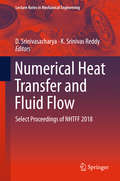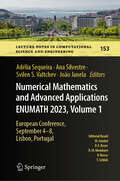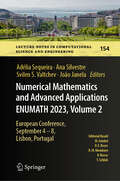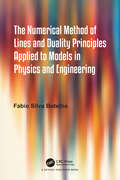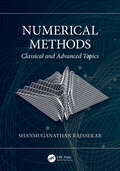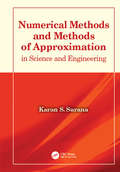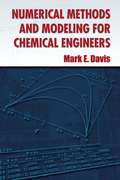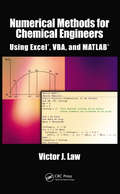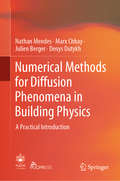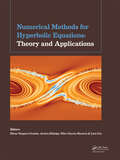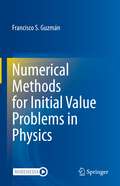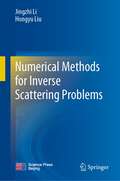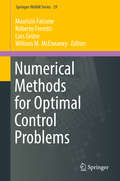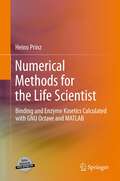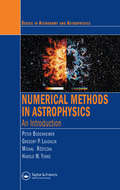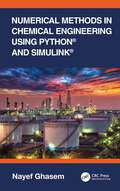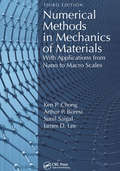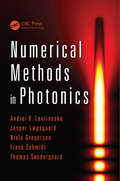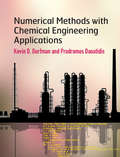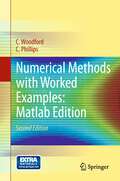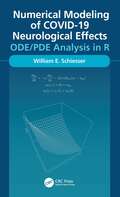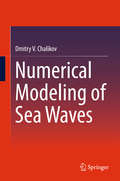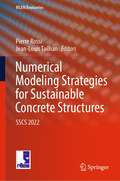- Table View
- List View
Numerical Heat Transfer and Fluid Flow: Select Proceedings Of NHTFF 2018 (Lecture Notes In Mechanical Engineering)
by D. Srinivasacharya K. Srinivas ReddyThis book comprises selected papers from the International Conference on Numerical Heat Transfer and Fluid Flow (NHTFF 2018), and presents the latest developments in computational methods in heat and mass transfer. It also discusses numerical methods such as finite element, finite difference, and finite volume applied to fluid flow problems. Providing a good balance between computational methods and analytical results applied to a wide variety of problems in heat transfer, transport and fluid mechanics, the book is a valuable resource for students and researchers working in the field of heat transfer and fluid dynamics.
Numerical Mathematics and Advanced Applications ENUMATH 2023, Volume 1: European Conference, September 4-8, Lisbon, Portugal (Lecture Notes in Computational Science and Engineering #153)
by Adélia Sequeira Ana Silvestre Svilen S. Valtchev João JanelaThis book gathers outstanding papers presented at the European Conference on Numerical Mathematics and Advanced Applications, ENUMATH 2023. The conference was held in Lisbon, Portugal, in September 2023. Leading experts in the field presented the latest results and ideas regarding the design, implementation and analysis of numerical algorithms, as well as their applications to relevant societal problems. ENUMATH is a series of conferences held every two years to provide a forum for discussing basic aspects and new trends in numerical mathematics and its scientific and industrial applications, all examined at the highest level of international expertise. The first ENUMATH was held in Paris in 1995, with successive installments at various sites across Europe, including Heidelberg (1997), Jyvaskyla (1999), lschia Porto (2001), Prague (2003), Santiago de Compostela (2005), Graz (2007), Uppsala (2009), Leicester (2011), Lausanne (2013), Ankara (2015), Bergen (2017), and Egmond aan Zee (2019).
Numerical Mathematics and Advanced Applications ENUMATH 2023, Volume 2: European Conference, September 4-8, Lisbon, Portugal (Lecture Notes in Computational Science and Engineering #154)
by Adélia Sequeira Ana Silvestre Svilen S. Valtchev João JanelaThis book gathers outstanding papers presented at the European Conference on Numerical Mathematics and Advanced Applications, ENUMATH 2023. The conference was held in Lisbon, Portugal, in September 2023. Leading experts in the field presented the latest results and ideas regarding the design, implementation and analysis of numerical algorithms, as well as their applications to relevant societal problems. ENUMATH is a series of conferences held every two years to provide a forum for discussing basic aspects and new trends in numerical mathematics and its scientific and industrial applications, all examined at the highest level of international expertise. The first ENUMATH was held in Paris in 1995, with successive installments at various sites across Europe, including Heidelberg (1997), Jyvaskyla (1999), lschia Porto (2001), Prague (2003), Santiago de Compostela (2005), Graz (2007), Uppsala (2009), Leicester (2011), Lausanne (2013), Ankara (2015), Bergen (2017), and Egmond aan Zee (2019).
The Numerical Method of Lines and Duality Principles Applied to Models in Physics and Engineering
by Fabio Silva BotelhoThe book includes theoretical and applied results of a generalization of the numerical method of lines. A Ginzburg-Landau type equation comprises the initial application, with detailed explanations about the establishment of the general line expressions. Approximate numerical procedures have been developed for a variety of equation types, including the related algorithms and software. The applications include the Ginzburg-Landau system in superconductivity, applications to the Navier-Stokes system in fluid mechanics and, among others, models in flight mechanics. In its second and final parts, the book develops duality principles and numerical results for other similar and related models. The book is meant for applied mathematicians, physicists and engineers interested in numerical methods and concerning duality theory. It is expected the text will serve as a valuable auxiliary project tool for some important engineering and physics fields of research.
Numerical Methods: Classical and Advanced Topics
by Shanmuganathan RajasekarThis book presents a pedagogical treatment of a wide range of numerical methods to suit the needs of undergraduate and postgraduate students, and teachers and researchers in physics, mathematics, and engineering. For each method, the derivation of the formula/algorithm, error analysis, case studies, applications in science and engineering and the special features are covered. A detailed presentation of solving time-dependent Schrödinger equation and nonlinear wave equations, along with the Monte Carlo techniques (to mention a few) will aid in students’ understanding of several physical phenomena including tunnelling, elastic collision of nonlinear waves, electronic distribution in atoms, and diffusion of neutrons through simulation study.The book covers advanced topics such as symplectic integrators and random number generators for desired distributions and Monte Carlo techniques, which are usually overlooked in other numerical methods textbooks. Interesting updates on classical topics include: curve fitting to a sigmoid and Gaussian functions and product of certain two functions, solving of differential equations in the presence of noise, and solving the time-independent Schrödinger equation.Solutions are presented in the forms of tables and graphs to provide visual aid and encourage a deeper comprehension of the topic. The step-by-step computations presented for most of the problems can be verifiable using a scientific calculator and is therefore appropriate for classroom teaching. The readers of the book will benefit from acquiring an acquittance, knowledge, experience and realization of significance of the numerical methods covered, their applicability to physical and engineering problems and the advantages of applying numerical methods over theoretical methods for specific problems.
Numerical Methods and Methods of Approximation in Science and Engineering
by Karan S. SuranaNumerical Methods and Methods of Approximation in Science and Engineering prepares students and other readers for advanced studies involving applied numerical and computational analysis. Focused on building a sound theoretical foundation, it uses a clear and simple approach backed by numerous worked examples to facilitate understanding of numerical methods and their application. Readers will learn to structure a sequence of operations into a program, using the programming language of their choice; this approach leads to a deeper understanding of the methods and their limitations. The text features highlighted examples, numerous problems, and a complete Solutions Manual for instructors.
Numerical Methods and Modeling for Chemical Engineers
by Mark E. DavisThis text introduces computational tools for solving differential equation models that arise in chemical engineering: diffusion-reactions, mass-heat transfer, and fluid flow. Geared toward advanced undergraduates or graduate students of chemical engineering studying applied mathematics, the treatment focuses on numerical methods and modeling implemented in commercial mathematical software available at the time of its initial publication in 1984. The introductory-level approach outlines numerical techniques for differential equations that either illustrate a computation property of interest or form the underlying methods of a computer software package. Readers are assumed to have a basic knowledge of mathematics, and results requiring further background feature appropriate references. Each chapter includes illustrative examples, and problems at the chapter's end simulate industrial mathematics projects and form extensions of the examples. Helpful appendixes supplement the text.
Numerical Methods for Chemical Engineers Using Excel, VBA, and MATLAB
by Victor J. LawWhile teaching the Numerical Methods for Engineers course over the last 15 years, the author found a need for a new textbook, one that was less elementary, provided applications and problems better suited for chemical engineers, and contained instruction in Visual Basic for Applications (VBA). This led to six years of developing teaching notes that
Numerical Methods for Diffusion Phenomena in Building Physics: A Practical Introduction
by Nathan Mendes Marx Chhay Julien Berger Denys DutykhThis book is the second edition of Numerical methods for diffusion phenomena in building physics: a practical introduction originally published by PUCPRESS (2016). It intends to stimulate research in simulation of diffusion problems in building physics, by providing an overview of mathematical models and numerical techniques such as the finite difference and finite-element methods traditionally used in building simulation tools. Nonconventional methods such as reduced order models, boundary integral approaches and spectral methods are presented, which might be considered in the next generation of building-energy-simulation tools. In this reviewed edition, an innovative way to simulate energy and hydrothermal performance are presented, bringing some light on innovative approaches in the field.
Numerical Methods for Hyperbolic Equations
by Elena Vázquez-Cendón Arturo Hidalgo Pilar García-Navarro Luis CeaNumerical Methods for Hyperbolic Equations is a collection of 49 articles presented at the International Conference on Numerical Methods for Hyperbolic Equations: Theory and Applications (Santiago de Compostela, Spain, 4-8 July 2011). The conference was organized to honour Professor Eleuterio Toro in the month of his 65th birthday. The topics cover
Numerical Methods for Initial Value Problems in Physics
by Francisco S. GuzmánThis textbook is a comprehensive overview of the construction, implementation, and application of important numerical methods for the solution of Initial Value Problems (IVPs). Beginning with IVPs involving Ordinary Differential Equations (ODEs) and progressing to problems with Partial Differential Equations (PDEs) in 1+1 and 3+1 dimensions, it provides readers with a clear and systematic progression from simple to complex concepts. The numerical methods selected in this textbook can solve a considerable variety of problems and the applications presented cover a wide range of topics, including population dynamics, chaos, celestial mechanics, geophysics, astrophysics, and more. Each chapter contains a variety of solved problems and exercises, with code included. These examples are designed to motivate and inspire readers to delve deeper into the state-of-the-art problems in their own fields. The code is written in Fortran 90, in a library-free style, making them easy to program and efficient to run. The appendix also includes the same code in C++, making the book accessible to a variety of programming backgrounds. At the end of each chapter, there are brief descriptions of how the methods could be improved, along with one or two projects that can be developed with the methods and codes described. These projects are highly engaging, from synchronization of chaos and message encryption to gravitational waves emitted by a binary system and non-linear absorption of a scalar field. With its clear explanations, hands-on approach, and practical examples, this textbook is an essential resource for advanced undergraduate and graduate students who want to the learn how to use numerical methods to tackle challenging problems.
Numerical Methods for Inverse Scattering Problems
by Jingzhi Li Hongyu LiuThis book highlights the latest developments on the numerical methods for inverse scattering problems associated with acoustic, electromagnetic, and elastic waves. Inverse scattering problems are concerned with identifying unknown or inaccessible objects by wave probing data, which makes possible many industrial and engineering applications including radar and sonar, medical imaging, nondestructive testing, remote sensing, and geophysical exploration. The mathematical study of inverse scattering problems is an active field of research. This book presents a comprehensive and unified mathematical treatment of various inverse scattering problems mainly from a numerical reconstruction perspective. It highlights the collaborative research outputs by the two groups of the authors yet surveys and reviews many existing results by global researchers in the literature. The book consists of three parts respectively corresponding to the studies on acoustic, electromagnetic, and elastic scattering problems. In each part, the authors start with in-depth theoretical and computational treatments of the forward scattering problems and then discuss various numerical reconstruction schemes for the associated inverse scattering problems in different scenarios of practical interest. In addition, the authors provide an overview of the existing results in the literature by other researchers. This book can serve as a handy reference for researchers or practitioners who are working on or implementing inverse scattering methods. It can also serve as a graduate textbook for research students who are interested in working on numerical algorithms for inverse scattering problems.
Numerical Methods for Mixed Finite Element Problems: Applications to Incompressible Materials and Contact Problems (Lecture Notes in Mathematics #2318)
by Jean Deteix Thierno Diop Michel FortinThis book focuses on iterative solvers and preconditioners for mixed finite element methods. It provides an overview of some of the state-of-the-art solvers for discrete systems with constraints such as those which arise from mixed formulations.Starting by recalling the basic theory of mixed finite element methods, the book goes on to discuss the augmented Lagrangian method and gives a summary of the standard iterative methods, describing their usage for mixed methods. Here, preconditioners are built from an approximate factorisation of the mixed system.A first set of applications is considered for incompressible elasticity problems and flow problems, including non-linear models.An account of the mixed formulation for Dirichlet’s boundary conditions is then given before turning to contact problems, where contact between incompressible bodies leads to problems with two constraints.This book is aimed at graduate students and researchers in the field of numerical methods and scientific computing.
Numerical Methods for Optimal Control Problems (Springer INdAM Series #29)
by Maurizio Falcone Roberto Ferretti Lars Grüne William M. McEneaneyThis work presents recent mathematical methods in the area of optimal control with a particular emphasis on the computational aspects and applications. Optimal control theory concerns the determination of control strategies for complex dynamical systems, in order to optimize some measure of their performance. Started in the 60's under the pressure of the "space race" between the US and the former USSR, the field now has a far wider scope, and embraces a variety of areas ranging from process control to traffic flow optimization, renewable resources exploitation and management of financial markets. These emerging applications require more and more efficient numerical methods for their solution, a very difficult task due the huge number of variables. The chapters of this volume give an up-to-date presentation of several recent methods in this area including fast dynamic programming algorithms, model predictive control and max-plus techniques. This book is addressed to researchers, graduate students and applied scientists working in the area of control problems, differential games and their applications.
Numerical Methods for the Life Scientist
by Heino PrinzEnzyme kinetics, binding kinetics and pharmacological dose-response curves are currently analyzed by a few standard methods. Some of these, like Michaelis-Menten enzyme kinetics, use plausible approximations, others, like Hill equations for dose-response curves, are outdated. Calculating realistic reaction schemes requires numerical mathematical routines which usually are not covered in the curricula of life science. This textbook will give a step-by-step introduction to numerical solutions of non-linear and differential equations. It will be accompanied with a set of programs to calculate any reaction scheme on any personal computer. Typical examples from analytical biochemistry and pharmacology can be used as versatile templates. When a reaction scheme is applied for data fitting, the resulting parameters may not be unique. Correlation of parameters will be discussed and simplification strategies will be offered.
Numerical Methods in Astrophysics: An Introduction (Series in Astronomy and Astrophysics)
by Peter Bodenheimer Gregory P. Laughlin Michal Rozyczka Tomasz Plewa Harold. W YorkeNumerical Methods in Astrophysics: An Introduction outlines various fundamental numerical methods that can solve gravitational dynamics, hydrodynamics, and radiation transport equations. This resource indicates which methods are most suitable for particular problems, demonstrates what the accuracy requirements are in numerical simulations, a
Numerical Methods in Chemical Engineering Using Python® and Simulink®
by Nayef GhasemNumerical methods are vital to the practice of chemical engineering, allowing for the solution of real-world problems. Written in a concise and practical format, this textbook introduces readers to the numerical methods required in the discipline of chemical engineering and enables them to validate their solutions using both Python and Simulink. Introduces numerical methods, followed by the solution of linear and nonlinear algebraic equations. Deals with the numerical integration of a definite function and solves initial and boundary value ordinary differential equations with different orders. Weaves in examples of various numerical methods and validates solutions to each with Python and Simulink graphical programming. Features appendices on how to use Python and Simulink. Aimed at advanced undergraduate and graduate chemical engineering students, as well as practicing chemical engineers, this textbook offers a guide to the use of two of the most widely used programs in the discipline. The textbook features numerous video lectures of applications and a solutions manual for qualifying instructors.
Numerical Methods in Computational Mechanics
by Jamshid Ghaboussi Xiping Steven WuThis book explores the numerical algorithms underpinning modern finite element based computational mechanics software. It covers all the major numerical methods that are used in computational mechanics. It reviews the basic concepts in linear algebra and advanced matrix theory, before covering solution of systems of equations, symmetric eigenvalue solution methods, and direct integration of discrete dynamic equations of motion, illustrated with numerical examples. This book suits a graduate course in mechanics based disciplines, and will help software developers in computational mechanics. Increased understanding of the underlying numerical methods will also help practicing engineers to use the computational mechanics software more effectively.
Numerical Methods in Mechanics of Materials: With Applications from Nano to Macro Scales
by Ken P. Chong Arthur P. Boresi Sunil Saigal James D. LeeIn the dynamic digital age, the widespread use of computers has transformed engineering and science. A realistic and successful solution of an engineering problem usually begins with an accurate physical model of the problem and a proper understanding of the assumptions employed. With computers and appropriate software we can model and analyze complex physical systems and problems. However, efficient and accurate use of numerical results obtained from computer programs requires considerable background and advanced working knowledge to avoid blunders and the blind acceptance of computer results. This book provides the background and knowledge necessary to avoid these pitfalls, especially the most commonly used numerical methods employed in the solution of physical problems. It offers an in-depth presentation of the numerical methods for scales from nano to macro in nine self-contained chapters with extensive problems and up-to-date references, covering: Trends and new developments in simulation and computation Weighted residuals methods Finite difference methods Finite element methods Finite strip/layer/prism methods Boundary element methods Meshless methods Molecular dynamics Multiphysics problems Multiscale methods
Numerical Methods in Photonics (Optical Sciences and Applications of Light #1)
by Niels Gregersen Andrei V. Lavrinenko Jesper Lægsgaard Frank Schmidt Thomas SøndergaardSimulation and modeling using numerical methods is one of the key instruments in any scientific work. In the field of photonics, a wide range of numerical methods are used for studying both fundamental optics and applications such as design, development, and optimization of photonic components. Modeling is key for developing improved photonic devices and reducing development time and cost. Choosing the appropriate computational method for a photonics modeling problem requires a clear understanding of the pros and cons of the available numerical methods. Numerical Methods in Photonics presents six of the most frequently used methods: FDTD, FDFD, 1+1D nonlinear propagation, modal method, Green’s function, and FEM. After an introductory chapter outlining the basics of Maxwell’s equations, the book includes self-contained chapters that focus on each of the methods. Each method is accompanied by a review of the mathematical principles in which it is based, along with sample scripts, illustrative examples of characteristic problem solving, and exercises. MATLAB® is used throughout the text. This book provides a solid basis to practice writing your own codes. The theoretical formulation is complemented by sets of exercises, which allow you to grasp the essence of the modeling tools.
Numerical Methods with Chemical Engineering Applications
by Kevin D. Dorfman Prodromos DaoutidisDesigned primarily for undergraduates, but also graduates and practitioners, this textbook integrates numerical methods and programming with applications from chemical engineering. Combining mathematical rigor with an informal writing style, it thoroughly introduces the theory underlying numerical methods, its translation into MATLAB programs, and its use for solving realistic problems. Specific topics covered include accuracy, convergence and numerical stability, as well as stiffness and ill-conditioning. MATLAB codes are developed from scratch, and their implementation is explained in detail, all while assuming limited programming knowledge. All scripts employed are downloadable, and built-in MATLAB functions are discussed and contextualised. Numerous examples and homework problems - from simple questions to extended case studies - accompany the text, allowing students to develop a deep appreciation for the range of real chemical engineering problems that can be solved using numerical methods. This is the ideal resource for a single-semester course on numerical methods, as well as other chemical engineering courses taught over multiple semesters.
Numerical Methods with Worked Examples: Matlab Edition
by C. Phillips C. WoodfordThis book is for students following an introductory course in numerical methods, numerical techniques or numerical analysis. It introduces MATLAB as a computing environment for experimenting with numerical methods. It approaches the subject from a pragmatic viewpoint; theory is kept at a minimum commensurate with comprehensive coverage of the subject and it contains abundant worked examples which provide easy understanding through a clear and concise theoretical treatment. This edition places even greater emphasis on 'learning by doing' than the previous edition. Fully documented MATLAB code for the numerical methods described in the book will be available as supplementary material to the book on http://extras.springer.com
Numerical Modeling of COVID-19 Neurological Effects: ODE/PDE Analysis in R
by William SchiesserCovid-19 is primarily a respiratory disease which results in impaired oxygenation of blood. The O2-deficient blood then moves through the body, and for the study in this book, the focus is on the blood flowing to the brain. The dynamics of blood flow along the brain capillaries and tissue is modeled as systems of ordinary and partial differential equations (ODE/PDEs). The ODE/PDE methodology is presented through a series of examples, 1. A basic one PDE model for O2 concentration in the brain capillary blood. 2. A two PDE model for O2 concentration in the brain capillary blood and in the brain tissue, with O2 transport across the blood brain barrier (BBB). 3. The two model extended to three PDEs to include the brain functional neuron cell density. Cognitive impairment could result from reduced neuron cell density in time and space (in the brain) that follows from lowered O2 concentration (hypoxia). The computer-based implementation of the example models is presented through routines coded (programmed) in R, a quality, open-source scientific computing system that is readily available from the Internet. Formal mathematics is minimized, e.g., no theorems and proofs. Rather, the presentation is through detailed examples that the reader/researcher/analyst can execute on modest computers. The PDE analysis is based on the method of lines (MOL), an established general algorithm for PDEs, implemented with finite differences. The routines are available from a download link so that the example models can be executed without having to first study numerical methods and computer coding. The routines can then be applied to variations and extensions of the blood/brain hypoxia models, such as changes in the ODE/PDE parameters (constants) and form of the model equations.
Numerical Modeling of Sea Waves
by Dmitry V. ChalikovPresenting a novel approach to wave theory, this book applies mathematical modeling to the investigation of sea waves. It presents problems, solutions and methods, and explores issues such as statistical properties of sea waves, generation of turbulence, Benjamin-Feir instability and the development of wave fields under the action of wind. Special attention is paid to the processes of dynamic wind-wave interaction, the formation of freak waves, as well as the role that sea waves play in the dynamic ocean/atmosphere system. It presents theoretical results which are followed by a description of the algorithms used in the development of wave forecasting models, and provides illustrations to assist understanding of the various models presented. This book provides an invaluable resource to oceanographers, specialists in fluid dynamics and advanced students interested in investigation of the widely known but poorly investigated phenomenon of sea waves.
Numerical Modeling Strategies for Sustainable Concrete Structures: SSCS 2022 (RILEM Bookseries #38)
by Pierre Rossi Jean-Louis TailhanThis volume highlights the latest advances, innovations, and applications in the field of sustainable concrete structures, as presented by scientists and engineers at the RILEM International Conference on Numerical Modeling Strategies for Sustainable Concrete Structures (SSCS), held in Marseille, France, on July 4-6, 2022. It demonstrates that numerical methods (finite elements, finite volumes, finite differences) are a relevant response to the challenge to optimize the utilization of cement in concrete constructions while checking that these constructions have a lifespan compatible with the stakes of sustainable development. They are indeed accurate tools for an optimized design of concrete constructions, and allow us to consider all types of complexities: for example, those linked to rheological, physicochemical and mechanical properties of concrete, those linked to the geometry of the structures or even to the environmental boundary conditions. This optimization must also respect constraints of time, money, security, energy, CO2 emissions, and, more generally, life cycle more reliably than the codes and analytical approaches currently used. Numerical methods are, undoubtedly, the best calculation tools at the service of concrete eco-construction. The contributions present traditional and new ideas that will open novel research directions and foster multidisciplinary collaboration between different specialists.
